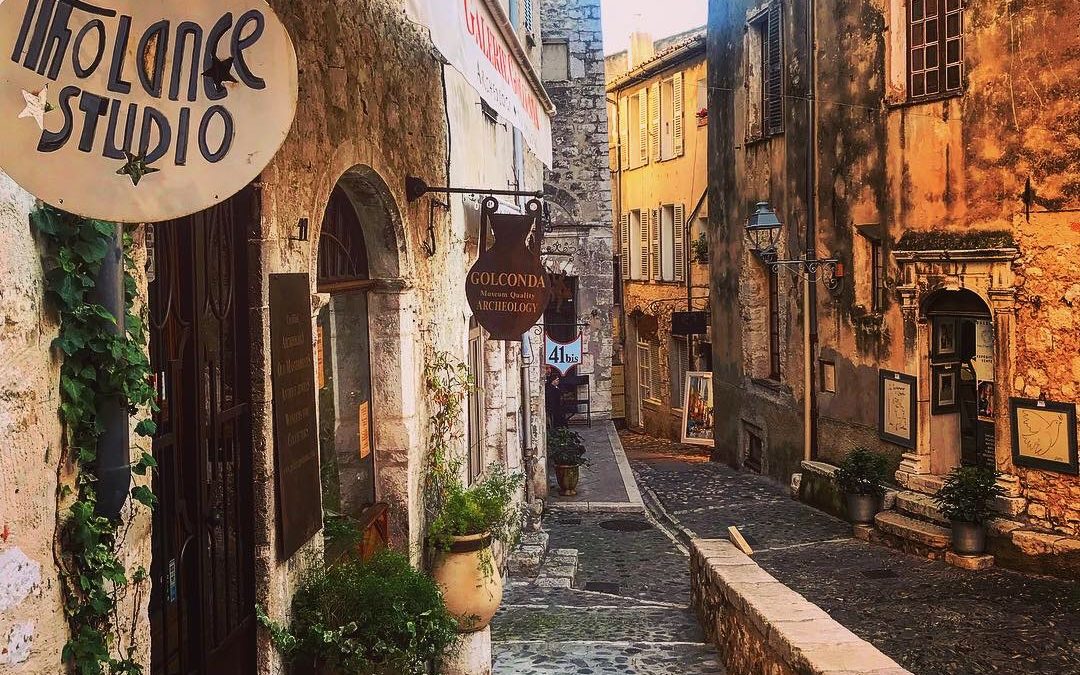
by Rebecca Taras | May 29, 2019 | Charming French Villages, Cote d'Azur, France, Historic, History, Luxury, Luxury Hotels, Perfume, Rebecca's stories, South of France, Travel
There’s no shortage of charming villages in France and while there are still many on my bucket list, I’ll never tire of Saint-Paul-de-Vence. Between the winding cobblestone streets, the remnants of some of the greatest artists and literary greats, and quaint restaurants with breathtaking views, Saint-Paul-de-Vence is worth venturing the short (and beautiful) drive on the winding roads if you’re visiting the South of France. Perched high on a hilltop, It just might arguably be one of the most beautiful villages in the Cote d’Azur…if not the entire country itself.
Fun Facts
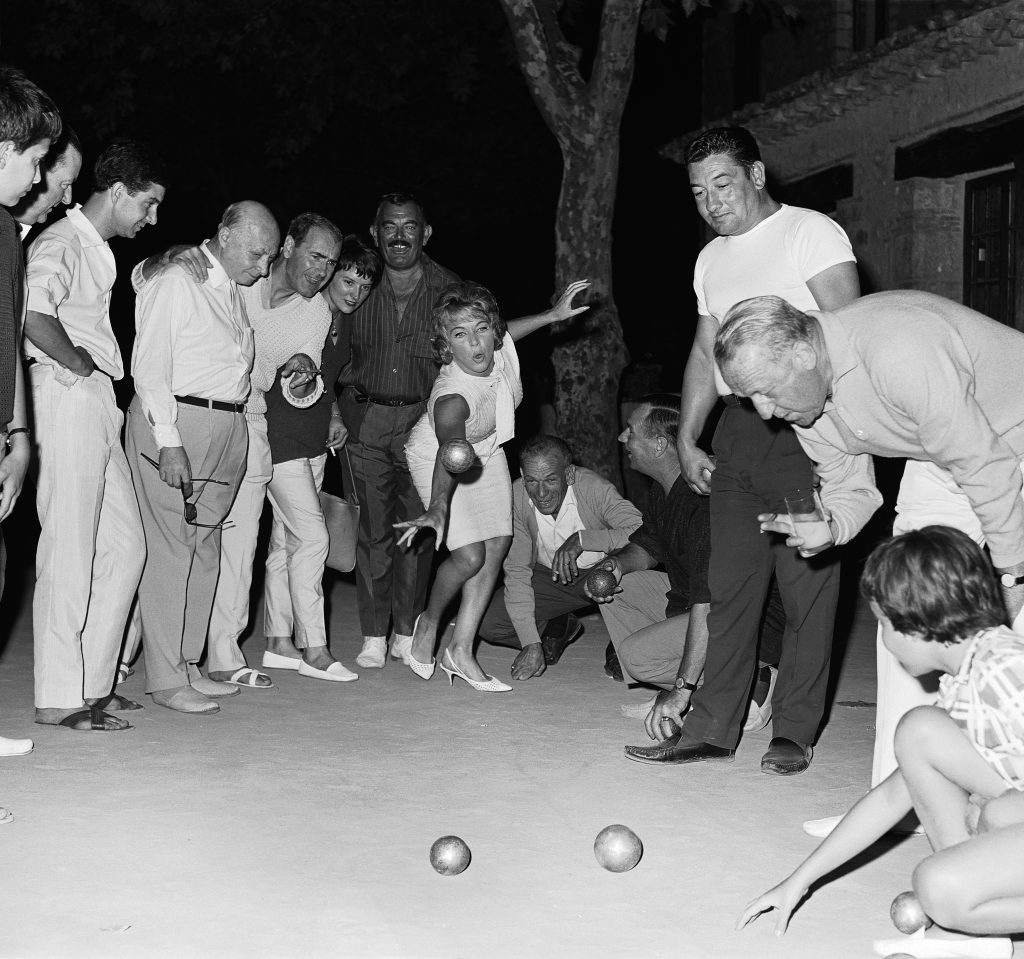
Singer Line Renaud: © Office de Tourisme de Saint-Paul de Vence – Photographe: Jacques Gomot
—Originally known as Saint-Paul, the village acquired the name Saint-Paul-de-Vence because of its proximity to the commune of Vence. This was a smart idea as it differentiated this dream world from nine other French villages bearing the same name. The cognomen Saint-Paul-de-Vence became official in 2011.
—Saint-Paul was a border stronghold in the Middle Ages (1388) when the County of Nice switched its allegiance from Provence to the County of Savoy. It remained a border town until 1860 when Savoy was annexed to France.
—The village became more accessible in 1911 due to a newly erected tramway between Cagnes-sur-Mer and Vence, via Saint-Paul. Aside from attracting curious visitors, the new method of transportation also made it possible to export
—During the roaring ‘20s, Saint-Paul started to attract what we now know as some of the greatest artists in the world— Paul Signac, Chaïm Soutine, and Raoul Dufy were among the artisans at the forefront. Captivated by the rich array of colors and natural lighting, the tranquil village was their muse.
—While the Côte d’Azur has long been associated as a playground for the rich and famous, Saint-Paul-de-Vence was on their radar, too. The paradisiacal village has attracted the likes of an array of notable personalities, to include Ernest Hemingway, Zelda and F Scott Fitzgerald, Yves Montand, Simone Signoret, James Baldwin, Marc Chagall, Charlie Chaplin, Vittorio de Sica, Curt Jurgens, Orson Welles, Line Renaud, Liza Minnelli, Kirk Douglas, Gene Wilder, and Michael Caine, to name a few.
—When you’re walking on the beautiful Provencal-style cobblestone streets, take note that they were barren until the ‘50s when Mayor Marius Issert turned the streets into what you can see today. Also interesting, the very first cobbles were brought back from the beach at Cagnes sur Mer.
Where To Stay
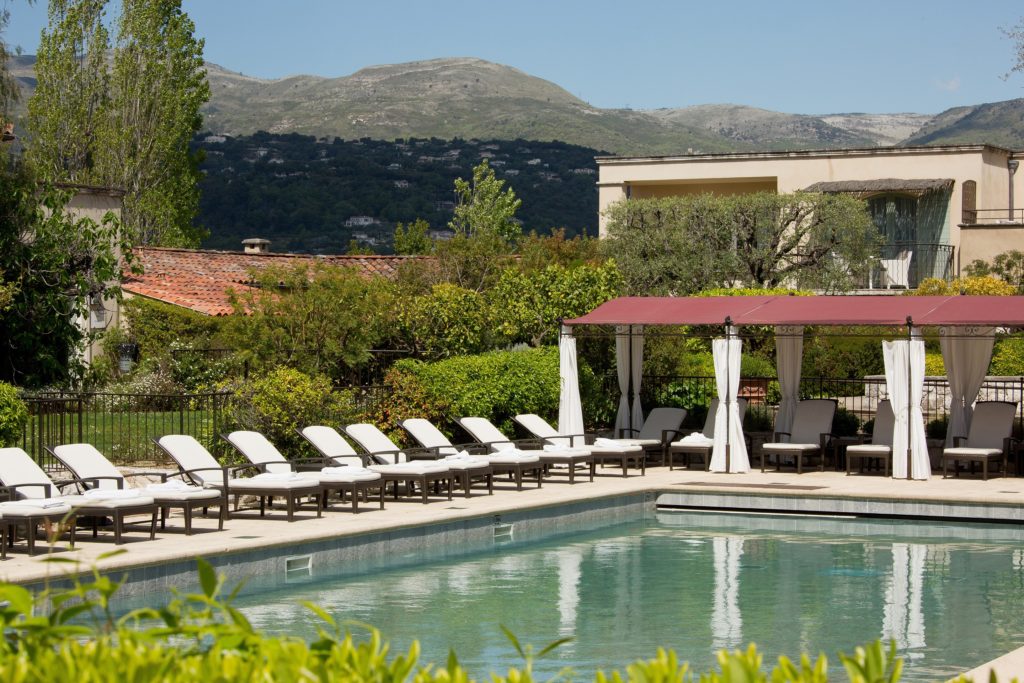
Photo courtesy of La Mas De Pierre
La Colombe d’Or: One can’t discuss lodging options in Saint-Paul-de-Vence without suggesting this historic gem. Back in 1920, the property was known as a cafe and bar called Chez Robinson. In an effort to support his wife Baptistine (Titine), its proprietor—painter/art collector Paul Roux—made additions to the property so that it could facilitate a small three-room inn known as Colombe d’Or. At this time, it served as an artist’s playground for legends such as Picasso and Matisse. Their work, along with pieces from several other greats, still resides in the hotel today for your viewing pleasure. Over the years, the property became a sought-after retreat for celebrities and A-listers alike. Luckily, the Colombe d’Or of today can accommodate more guests—it boasts 13 rooms and 12 suites to be exact. You’ll find modern-day conveniences such as dry cleaning and room service. Speaking of food, even if you’re not a guest, you’re going to want to eat at the on-site restaurant. The menu features quintessential Provencal-style dishes such as stuffed baby vegetables, baked Provençal tomatoes, and a variety of fresh fish and meat dishes. If you visit in the warm weather months, you’ll be treated to the secret garden-like outdoor terrace. As of the this post, room rates range between 250 and 430 euros per night depending on room selection and season.
Le Saint Paul: Also conveniently located within the village, this five star property (a previous residence from the 16th century) possesses 16 rooms and terrace suites with sweeping views of the Medieval village and area surroundings. Take a meal out on the sprawling terrace where you can choose from menu items that correspond with the season. It’s worth taking an extra cup of coffee (or glass of wine) to soak up the awe-inspiring environs the French way—by taking your time. As of this post, room rates range between 250 and 630 euros per night depending on room selection and season.
Le Mas de Pierre: I had the pleasure of recently staying at this Eden and let’s just say that I didn’t want to leave! Le Mas de Pierre is a five-star boutique hotel (Relais and Chateaux) that’s located just on the outskirts of town. A mas, to be clear, is defined as a Provençal-style farmhouse, which is exactly what this place feels like on an elevated level. The property is surrounded by spectacular landscape that includes commanding mountains; centuries-old olive trees; and aromatic fig, orange, and lemon trees that dot the hotel grounds. As there are less than 60 rooms (cleverly divided amongst several buildings for the utmost in privacy), the feeling here is more like staying at a private estate than a big hotel. The service is impeccable, the decor is on-point, and I love that every room has a private (and generous) balcony or garden. Flying doves (literally) make their way around the grounds, on-site herb and vegetable gardens provide inspiration for the chef, you can visit the hotel owner’s birds in the exotic garden, and the last greenhouse in this historic area of greenhouses is used to cultivate all the orchids and plants in and out of the hotel. As of this post, room rates range between 215 and 1848 euros per night depending on room selection and season.
Where To Eat
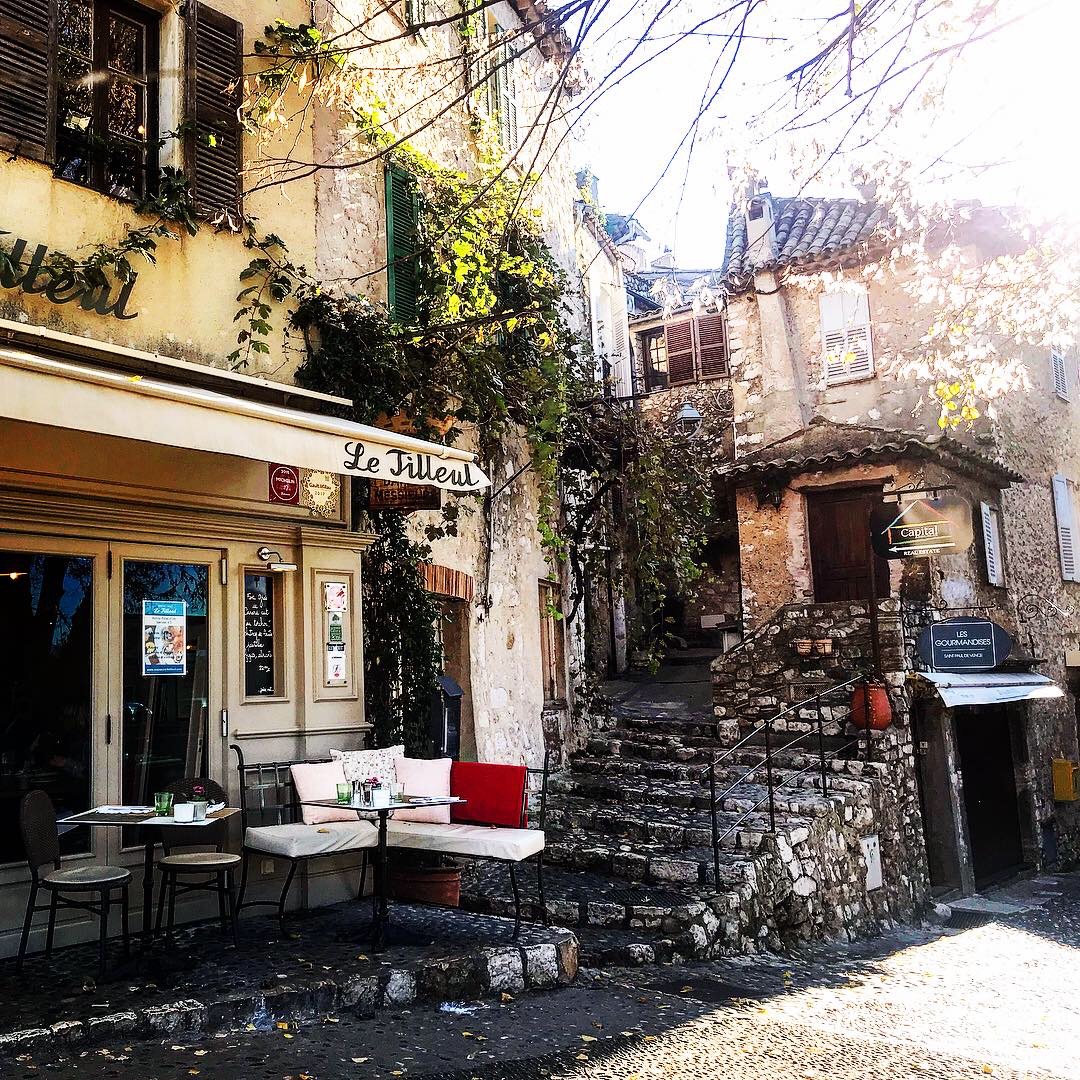
Le Tilleul: Photographed by Rebecca Taras
Le Tilleul: Not only is this charming eatery perfectly positioned for people watching and immersing yourself in village life, the food is fantastic. The seasonally changing menu is gastronomic, yet comfortable—you can even find a simple sandwich on the lunch carte if you aren’t in the mood for a feast, but still want to enjoy the views. When I visited with my boyfriend, it was a crisp fall day, but blankets were available at all of the chairs. We used ours (and a bottle of red wine) to keep warm. Along with the complimentary olive tapenade, we shared two of the starters of the day: shrimp with avocado cream (artfully nestled in a small, clear glass) and cured salmon gravlax, which was served with a mini salad lightly tossed in a zesty citrus dressing. For the mains, my S.O. had a filet with nicoise olive mashed potatoes and I opted for the linguini con le vongole—aka linguini with clam sauce. Even though we cleaned each and every plate, we still managed to save room for one of the house-made desserts: a berry coulis and cream trifle.
La Brouette: While this restaurant is not exactly French, the Danish cuisine is as delectable as the owners (and hosts) are charming and hospitable—it wouldn’t be around for 40-plus years otherwise! Specialties include Baltic herring, house-marinated and smoked salmon, smoked trout, and a selection of Danish desserts. During the warm weather months, make a reservation for the rustic, lush patio where you can catch the fireworks on selected nights during the summer. When the chill hits the air, the inside is just as cozy, thanks to a warm burning fireplace.
(See above for information on the restaurant at Colombe d’Or.)
Where To Shop
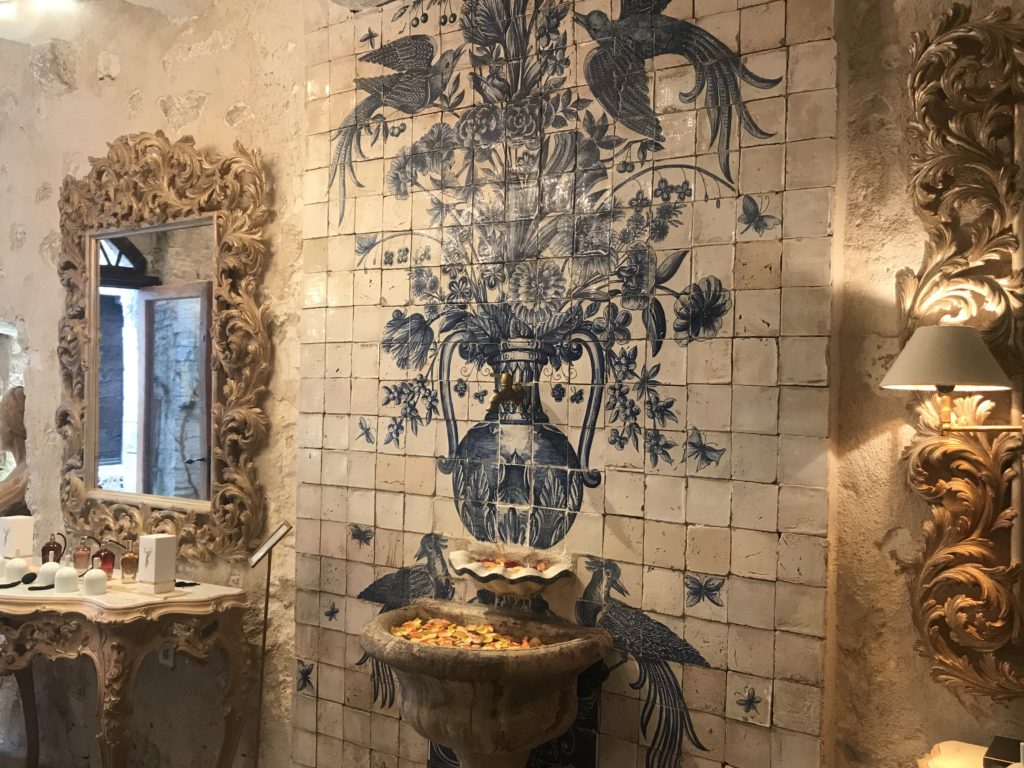
La Maison Godet: Photographed by Rebecca Taras
Galerie Frédéric Gollong: This illustrious gallery one of the first art spaces to open in Saint-Paul de Vence. Along with works from historic greats such as Matisse, Picasso, Valodon, Alechinsky, Braque, and Miró, you’ll also find more contemporary pieces from Van Velde, Wimmer, Berthois-Rigal, and Coignard, to name a few.
Galerie Le Capricorne: A diverse gallery that features a wide array of classic and contemporary works in various styles, to include landscapes, street art, abstract, pop art, and illustrations. You’ll find stunning pieces from great masters like Picasso, Chagall, Matisse, and Braque, as well as contemporary creations from artisans such as Michel Dejos, Isabelle Plante, Sylvia Karle-Marquet, Claude Fauchere, and Christophe Gallard, among several others.
La Maison Godet Parfum: A personal favorite, this perfume house dates back to 1901, and has since then whipped up umpteen fragrances that pay homage to everything from cognac (the family’s first business) to the muses of some of the greatest artists milling around Saint-Paul-de-Vence back in the day. All fragrances are made locally and it’s not uncommon that they contain ingredients found right in the village—like figs from the tree at Colombe d’Or. The current “nose” is the great granddaughter (Sonia) of founder Julien-Joseph Godet. If you’re lucky enough, she’ll be in the shop the day you visit; brace yourself for a real treat.
La Petite Cave de Saint Paul: Housed in a 14th century wine cellar, this cavernous shop offers an array of wines from the region of Provence. Wine and spirit aficionados will appreciate the well-curated selection of Cognac, Calvados, Armagnac, champagne, Bordeaux Grands Crus, and some of the best bottles from Burgundy and the Rhone Valley.
Where To Visit
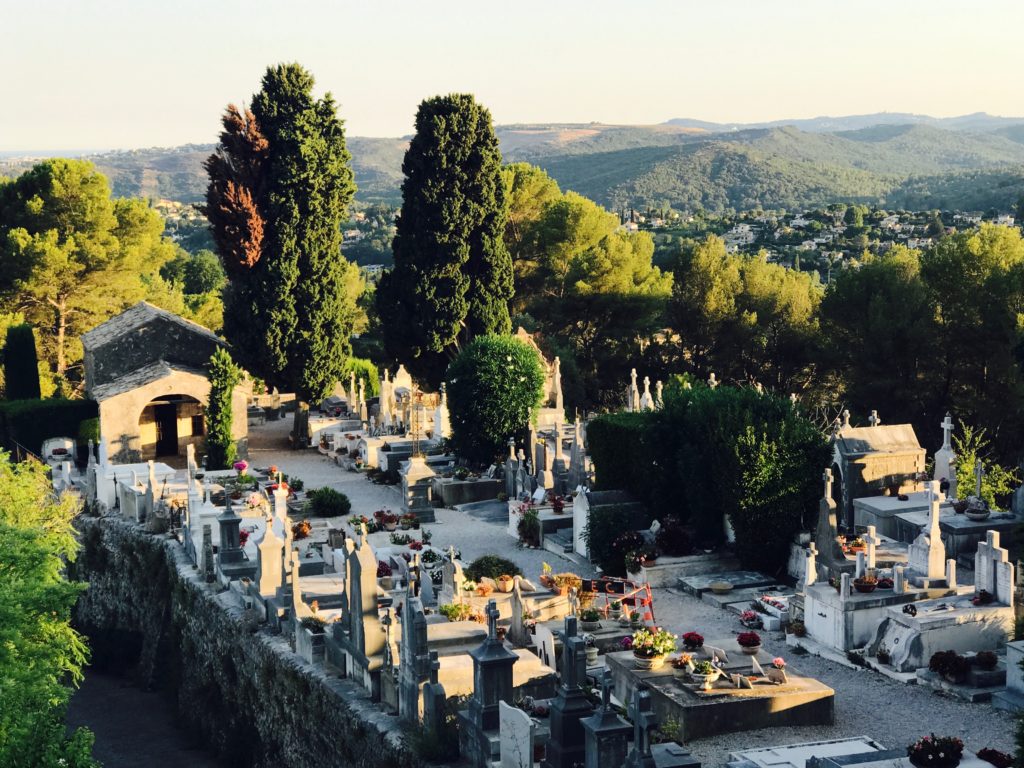
Cimetiere de Saint-Paul-De-Vence: Photographed by Rebecca Taras
Fondation Maeght: Going on 50-plus years, the Fondation Maeght features the largest and most influential collections of 20th century art in all of Europe.
Musée de Saint-Paul: Take a deeper dive into the artistic history of Saint-Paul by visiting this well-appointed museum that’s housed in a stone house from the 16th century. Exhibitions change regularly and typically feature the works of artists whose works are associated with the village.
Cimetière de Saint-Paul-De-Vence: Dating back to the 16th century, this quaint cimetière is the resting place of famous locals such as Chagall (known for his paintings of the area) and Marguerite et Aimé Maeght, art gallery owners and dealers who lost their son Bernard at the age of 11—he is also buried here. Fondation Maeght became their project to get through this tragedy.
Jacques Prévert’s House: Ask a local to point you in the direction of French poet and screenwriter Jacques Prévert’s house, an unapologetically charming stone abode where he lived with his wife his wife Janine. Prévert was friends with Pablo Picasso and Paul Roux, owner of the Colombe d’Or.
Place de la Grande Fontaine: A vaulted washhouse serves as a memory for the old town square. Today, it’s a spot for locals to sell farm fresh produce.
Planning Your Trip
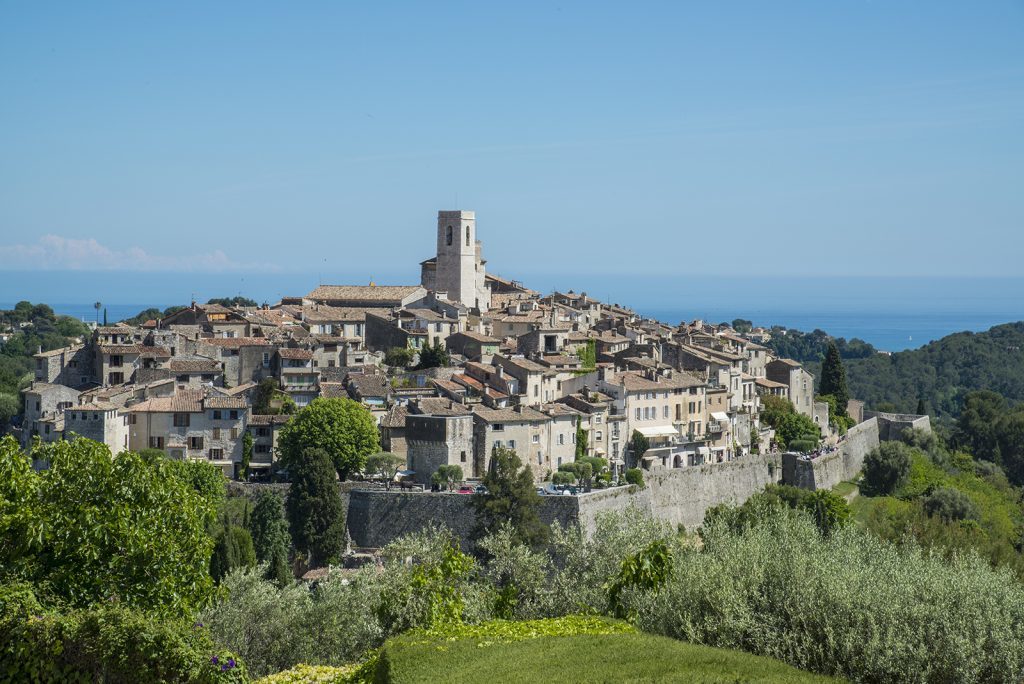
Le Village de St.-Paul-de-Vence
© Office de Tourisme de Saint-Paul de Vence – Photographe: Elisabeth Rossolin
By no means are my suggestions a complete list of what you can eat, do, and, see in Saint-Paul-de-Vence, but they are definitely both personal and popular favorites. Don’t be afraid to visit in the off-season as summer can be overwhelmingly crowded, which makes it difficult to book a table at a restaurant, a room at a hotel, or to full enjoy the shops and sites. Have you ever visited this charming French village? What are your favorite places?
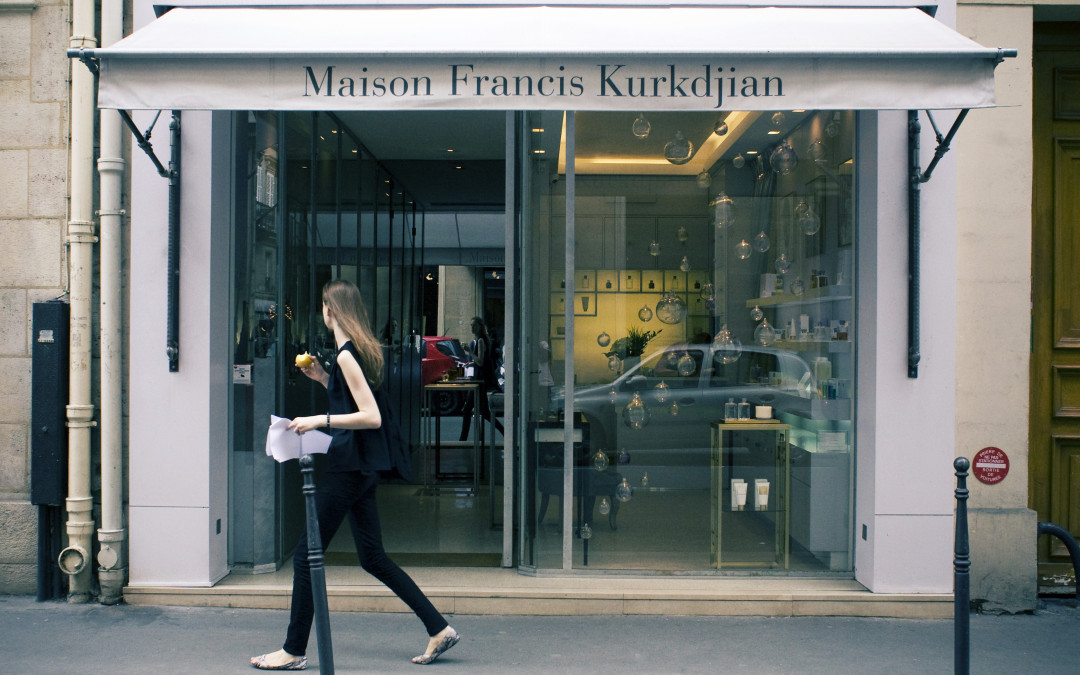
by Rebecca Taras | Mar 1, 2019 | France, Perfume
When I attended the Bal Magique du Maroc for the Woman’s Board of The Alliance Française de Chicago back in 2012, I had no idea that years later I’d be chatting with award-winning perfumer Francis Kurkdjian at his Fragrance Maison in the Marais arrondissement in Paris. Not only was he in attendance at the ball, but he created an orange-filled tile fountain that permeated the dance floor with an exotic scent created especially for the fête. Such installations are part of what makes Kurkdjian such an olfactive genius. In fact, he was honored with the Chevalier des Arts et des Lettres by the French Government in 2008.
Perhaps even more familiar to the average consumer, however, would be Kurkdjian’s scented imprint on the mainstream fragrance world: Starting at the tender age of 25, the perfumer was responsible for formulating such iconic scents as Le Male for Jean-Paul Gaultier, My Burberry and Narciso Rodriguez For Her, among others.
In 2001, he also made a name for himself by becoming the first perfumer to open a bespoke custom fragrance workshop. Eight years later, he founded his eponymous House of Perfume, where this interview took place. I sat next to the Versace-clad Frenchman, among all of his ambrosial creations, thankful that I opted to spritz on a little perfume before I left the door that morning.
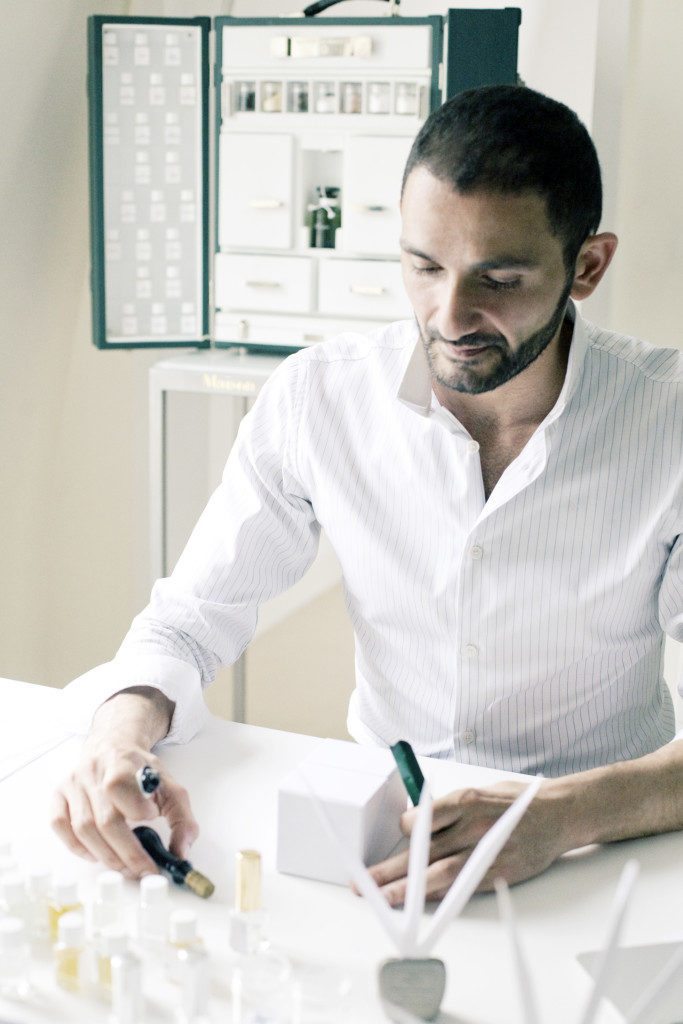
Photo courtesy of N. Baetens.
Just two years out of college you developed Le Male, one of the world’s most popular fragrances, with 40-plus to follow. Is it safe to say that you’re a natural perfumer? “No, it’s not natural. I always try to push my boundaries of the craft, but there is no secret. At the end of the day, you have to pretend it’s easy because no one wants to feel pain, to see pain. I’m not saying it’s painful to make a fragrance, but it’s all about work.”
What is your creation process like, and what steps do you take for each individual project? “Creating perfume is like writing a book. It’s storytelling. Whether I work for another brand, my brand, or on an installation, what is important is what you have to say and if there is a different way in which you want to say it. So, then when you have the story, making the fragrance is easy.”
“In a way, the inspiration for the story is the most difficult part, as it’s the most intangible part of the process. Otherwise it’s just technique, and technique is work. At some point, everyone can have a good technique, and that’s the difference between the artisan and the artist. You have to be above the technique. You have to master it in such a way that you forget the technique. The technique and the work of the perfumery is the base, and if you don’t have that in mind or if you don’t know how to handle [the technique] then you’ll go nowhere.”
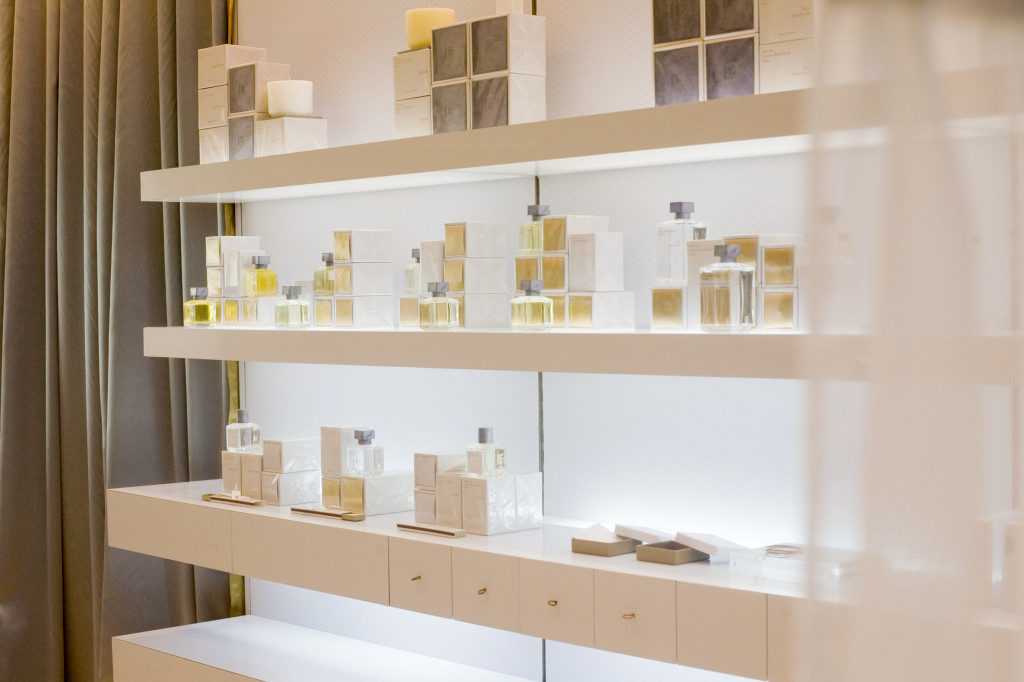
Photo courtesy of N. Baetens.
Where do you seek your inspiration? What inspires you? “I would say the world we live in inspires me because we live in the 21st century, which is very important. I don’t like to be nostalgic. I don’t like to be historical about things from the past—even though you have to learn history to be able to understand today, as well as the future, because history is a cyclical process.”
“The idea of building the olfactif wardrobe became perfect in my mind because I felt the way women were wearing fragrance was not adapted to the modern woman. In my mind, modernity for a woman is about the diversity of each woman and being who they really want to be. I couldn’t see myself just thinking about a woman wearing one type of perfume forever. After all, you change your haircolor, makeup and wardrobe, so why not your perfume? In the past, people would have a different fragrance for different activities throughout the day. This is why you need to know the history, because you must think how it can be managed and twisted to our contemporary lives.”
It’s been said that we naturally gravitate toward essential oils that our body or psyche needs at the moment. Would you say that’s the same idea when it comes to choosing a perfume made with essential oils? “No, I think it goes beyond that because a good perfume is when you forget the ingredients. When you hear music, you don’t go to the notes. I play the piano, so I learned all about music for years. But when I listen to music, it’s not about the notes anymore—it’s about the melody. Perfume works exactly the same way.”
“Even though [perfume] can be somewhat straightforward, like my À la rose for example. Of course, you would expect it to have roses, but it’s put together in such in a way that you don’t smell the rose you were expecting. The ingredients have to disappear behind the emotion. This is when you reach the level of an artistic feeling. You forget the music, you forget the notes.”

Photo courtesy of N. Baetens.
When was the moment that you decided you wanted to branch off on your own? “It took me 10 years to go forward. The first step was when I opened my bespoke fragrances atelier in 2001. The Maison opened in 2009, so it took several years. You have to find the right partner, and have the right people around you. (Editor’s note: Kurkdjian’s business partner is Marc Chaya, a former partner at Ernst & Young.) It’s a question of timing, in my mind. And you can’t rush—it’s never a good idea to rush. I like speed a lot, but sometimes you have to wait a little bit. It’s worth it.”
I know that you are involved in a lot of collaborations. How did you get involved in the installation on the Champs-Élysées in connection with your À la rose fragrance? “I created the perfume À la rose in 2014/2015 for the U.S. and Europe, and a year before in Japan, where it was awarded Best Fragrance at the 2015 Japan Fragrance Foundation awards. I was inspired by a painting called Marie-Antoinette dit à la Rose (Marie-Antoinette with the Rose), which you can see on display at the Champs-Elysées entrance of the Vigée Le Brun exhibition.”
“The portrait is of Antoinette holding a rose in her hand—the same type of rose that I use today in my perfumes. The story behind the painting is fascinating: The original was a scandal because Antoinette was not painted as a queen, but as a bourjois, nonchalant woman. This was done because she wanted to gain popularity with the people of France at the time, but they wound up being shocked instead.”
“So, they had to redo a second portrait in the same pose dressed in her proper attire, etc. I thought the subject behind the painting was very modern, and it showed me that if a subject was modern, the idea of playing around with the name rose—which seems a little bit old fashioned—was relevant at the time. Once the museum heard that my fragrance was inspired by that painting, they asked me to create an installation for the opening of the exhibit.”
Speaking of Marie-Antoinette, can you briefly explain what went into re-creating her original perfume? Who was the initial perfumer? “The name of the original perfumer at the time was Jean-Louis Fargeon. He was from a family of perfumers; his father was the producer for Louis XV. We found the original formulas in the archives from the castle at the National Library of France. With that, we were capable of recreating, recompounding one of the original formulas.”
I was curious to know a little bit more about the room deodorizing papers that you created. “It’s an old idea from the 19th century that was very popular. Before paper it was ribbon. It was called Ribbon des Bruges from Belgium—fabric was less expensive than paper at the time. My papers are more modern due to the packaging and the scent, which incorporates some of the fragrances in the House.”
What are you currently working on? “We are preparing a huge collaboration with Baccarat for early next year. Something rather huge is coming up at the Musée National d’Art Moderne in early February. We are also scent-designing a couple of hotels around the world—Cannes, the Caribbean…”
How long does scent development take? “I could write down a formula and create a fragrance in 20-minutes. Time doesn’t mean anything to me anymore because I’ve been formulating for 20 years. When I first started, it may have taken me eight months. People love timing things—numbers are important to people because it’s tangible. But creation is totally invisible.”
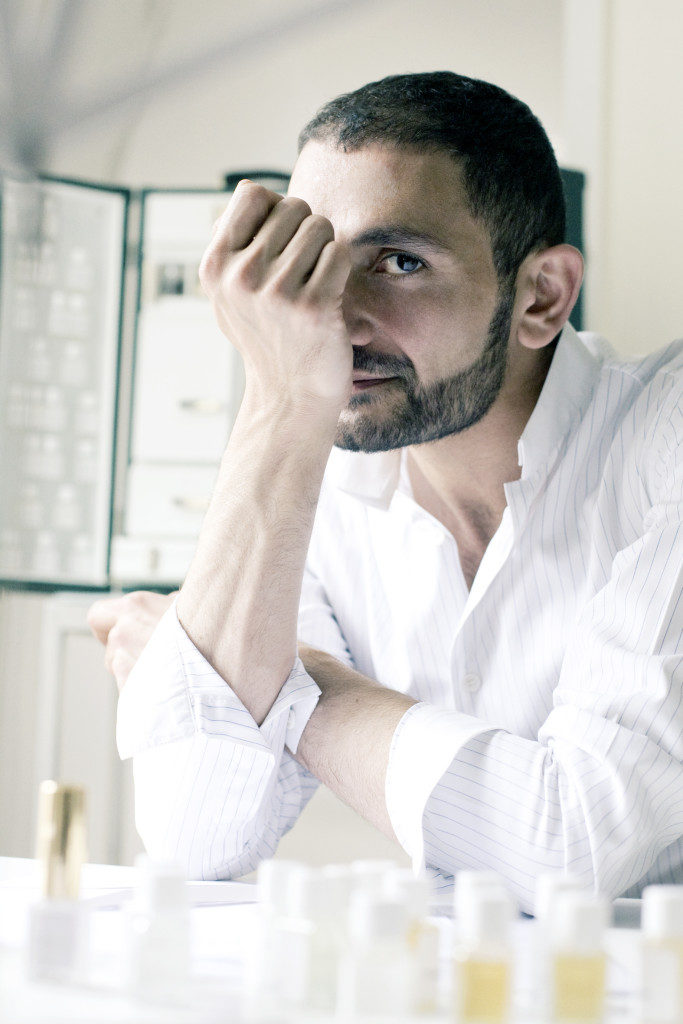
Photo courtesy of N. Baetens.
WTB Signature Questions:
What do you always have in your carry-on when you travel? “I always have a cashmere blanket, laptop, passport, maybe my two cellphones and a charger, keys to come home, and one of my scented leather cards, which scents my personally designed leather bag. We’re launching fragrance-enhanced leather accessories. It’s a technique that was used 800 years ago to scent the leather, but I modernized it by making a wallet, coin purses and things like that. The scent lasts two-to-three years.”
What is one of your favorite travel destinations, and what is on your bucket list? “Anywhere can be super-exciting. It just depends on what you do and who you are with. A journey can be boring if you are bored yourself. It’s more a question of your energy. I’ve seen many wonderful things, I’m very blessed, but what is on my list? As far as the United States isconcerned, I would love to see Niagara Falls and the Grand Canyon. Otherwise, I think it would be more like a journey in time. To go forward 100 years to see what we do with all the mess we are living with now, to see what all this is going to come to. To see how perfume would be. That would be amazing.”












